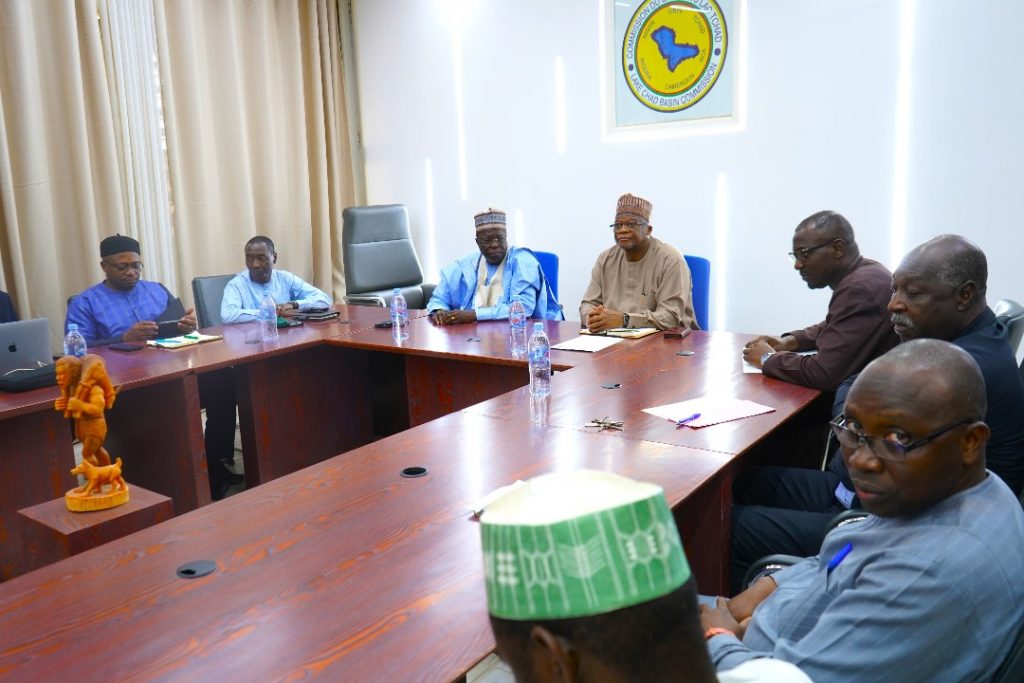LCBC and SEMRY Renew Framework Partnership Agreement

LCBC and SEMRY Renew Framework Partnership Agreement
Since 16 October 2023, a delegation from the Rice Farming Modernization and Development Corporation of Yagoua (SEMRY), with its head office in Cameroon, has been visiting the headquarters of LCBC in N’Djamena.

The fifteen-strong man delegation was led by Mr. ZOUTENE DOUFENE, Director General of Planning and Regional Development at Cameroon’s Ministry of the Economy, Planning and Regional Development (MINEPAT). During this five-day mission, the Framework Partnership Agreement between LCBC and this public capital company, based in the northern part of Cameroon, will be renewed. SEMRY’s mission includes developing the rice industry through the Project for the Development and Valorisation of Investments in the Logone Valley (VIVA LOGONE).
As a reminder, an initial Framework Partnership Agreement was signed between LCBC and SEMRY in May 2016 via the Emergency Flood Control Project in the Far North Region (PULCI). Its main aim was to develop an early warning, data collection and management system with a view to preventing flooding in the Logone River sub-basin. This agreement enabled an inventory of hydrometric and meteorological networks in the area. Some twenty hydrometric and meteorological stations were rehabilitated and equipped in this area, straddling Cameroon and Chad, and a flood early warning system was developed. It also contributed to continuously monitoring the meteorological and hydrometric network in the Logone sub-basin, supporting the setting up and operation of a system for collecting and managing hydrometric and meteorological data, and providing a mechanism for sustaining the achievements of PULCI. In a nutshell, it contributed to and participated in achieving the objectives of the Lake Chad Basin Observatory and the LCBC Water Charter.
The occurrence of the COVID pandemic in 2019 undermined this smooth collaboration. And the end of the PULCI, in June 2020, put the finishing touches to this good collaboration.
The VIVA Logone Project – of which SEMRY is the main executing agency – has deemed it useful to continue in the still-fresh footsteps of the PULCI, to continue and capitalise on activities undertaken as part of PULCI, and above all, with the aim of consolidating an early warning system likely to sustain the hydro-agricultural developments in the Logone Valley, protect the populations against flooding and ensure hydrometeorological monitoring in the Lake Chad basin in general.
Above all, as extreme weather events of recent years so clearly illustrate, climate issues in general, and meteorological issues in particular, know no borders. So, insofar as the climate knows no borders, a common integrated approach is in everyone’s interest.
It is the rationale for the continuation of this fruitful collaboration between LCBC – one of whose cardinal missions is precisely the management of transboundary water resources – and SEMRY, which aims to boost production from hydro-agricultural schemes in the Logone Valley while at the same time providing security for the population and their incomes. In this regard, both institutions agreed to carry out an exhaustive assessment of the implementation of the former agreement, with a view to capitalising on the good practices and shortcomings recorded.
They decided by mutual agreement to set up a technical working group, made up of experts from both parties, to review the old agreement and consider how to implement a new Convention, the outcome of which will be the establishment of a proven model for a functional hydrometeorological system, beneficial not only to Cameroon and Chad but also to all LCBC Member States.
Speaking on the occasion, the Director General of Planning and Regional Development at MINEPAT recalled that this “meeting is the culmination of a long process, which began with the implementation of a first Framework Partnership Agreement between LCBC and SEMRY through the Emergency Flood Control Project (PULCI) in the Far North Region of Cameroon. It also expresses the need for the Cameroonian authorities to extend the hydrometeorological monitoring network in the Logone Valley from the SEMRY intervention area to the mouth of Lake Chad, the continuation and capitalisation of actions undertaken under the first Agreement between SEMRY and LCBC…”
In chairing the opening ceremony, the Executive Secretary, Ambassador MAMMAN NUHU, reiterated his warmest thanks to the government of Cameroon “for involving LCBC in the implementation of this project, in accordance with the spirit of the Lake Chad Basin Water Charter”. He further stated that the VIVA LOGONE project was authorised by the Executive Secretariat in March 2021, in keeping with the articles of the Water Charter to the planned measures. He thanked the World Bank (the VIVA LOGONE project’s donor) for its invaluable contribution to the recovery and revival of development in the Lake Chad Basin region.
Over the next five days, both parties will review the Draft Framework Partnership Agreement and the terms and conditions for its implementation before proceeding to sign it. Already, discussions will focus on the following: (i) management of hydrometric and meteorological data and information, (ii) establishment of an early warning system, (iii) raising awareness among the population in the project area, (iv) management of the Logone flood plain, (v) development of partnerships, (vi) mobilisation of funding, (vii) establishment of a system for communicating and capitalising on the Project’s outcomes, (viii) capacity-building among the stakeholders and (ix) experience sharing.
The renewal of this Partnership Agreement between LCBC and SEMRY will further enhance and consolidate the excellent relations of friendship and fraternity between SEMRY and LCBC on the one hand and between Cameroon and Chad on the other. Above all, it will make the exchange of information between the various stakeholders on water resources in the Lake Chad Basin in general and in the area of intervention of the VIVA LOGONE Project more dynamic and effective.





